| Library | Lane | Search Lane | Catalog |
| Contact Us | Web Site Accessibility |

| Don Macnaughtan | Lane Community
College Library Eugene, Oregon 97405 macnaughtand@lanecc.edu |

 "Where no ship had ever before been, and situated as this Island is in the midst of a prodigious Ocean..." Arthur Bowes Smyth, HMS Lady Penrhyn 1788 |
The Mystery Islands of South Polynesia
Bibliography of Prehistoric Settlement on Norfolk Island, the Kermadecs, Lord Howe, and the Auckland Islands
 2001 Don Macnaughtan
2001 Don Macnaughtan
Island Bibliographies no. 1
 Introduction
Introduction Prehistory of Norfolk Island
Prehistory of Norfolk Island Prehistory of the Kermadecs
Prehistory of the Kermadecs Prehistory of Lord Howe Island
Prehistory of Lord Howe Island Prehistory of the Sub-Antarctic Islands
Prehistory of the Sub-Antarctic Islands Offshore islands and maritime explorations in Australian prehistory
Offshore islands and maritime explorations in Australian prehistory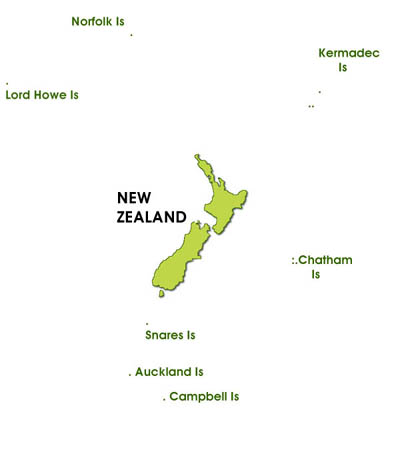
New Zealand and the remote oceanic islands of South Polynesia
Introduction
The spread of the Polynesians and Micronesians into the vastness of the Pacific Ocean is one of the great dramas of human history. Beginning over 3,000 years ago, people began to spill out of the island chains of Indonesia, Melanesia and the Philippines into the scattered atolls and volcanic islands of the Pacific Ocean. By about 1000AD, most of the habitable islands of the world's greatest ocean supported thriving populations. The speed and daring of this expansion was incredible. Humans had touched almost every speck in the Pacific, sailing on double-hulled canoes across trackless expanses in search of new homes. In every sense, this was one of the most extraordinary migrations in human history.
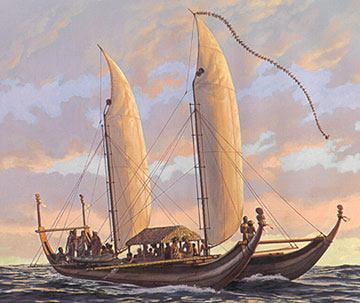
The last places to be reached were in the southwest Pacific, and in the far eastern Pacific. Settlers reached all the way to Easter Island, 2300 miles from the coast of South America, by about 700AD. In the southwest Pacific, voyaging canoes reached New Zealand around 1250AD, and the remote, cool and windy archipelago of the Chatham Islands around 1300AD (New Zealand was in fact the last major land mass on the planet to be settled by humans - Iceland was settled about 800AD, and Madagascar some hundreds of years earlier.) After New Zealand, the Pacific was full, and long-range voyaging began to decline quite rapidly.
A few habitable Pacific islands were never found until Europeans entered the ocean - they rank as amongst the last places on earth discovered by humans. These include the Galapagos Islands, the Revillagigedos Archipelago, and the Juan Fernandez Islands off the coast of South America; Lord Howe Island in the Tasman Sea between Australia and New Zealand; and Midway Island, northwest of Hawaii. They are some of the few places on the planet which have never had an "indigenous" population.
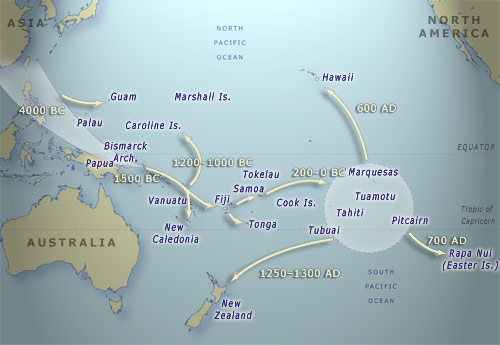
Diffusion of human settlement across time and space in the Pacific
However, there are also some islands in the Pacific that were once settled by prehistoric people, then abandoned. These have been called the "mystery islands" by anthropologists, because there are often very few clues about what happened to their people. Some of the "mystery islands" include Necker and Nihoa Islands, northwest of Hawaii; Walpole, near New Caledonia; Pitcairn and Henderson in the eastern Pacific; Palmerston and Suwarrow in the Cook Islands; the Bonin Islands, 600 miles south of Japan; and several of the Phoenix and Line Islands in the central Pacific. Additionally, there are some famous "mystery islands" off the Australian coast, notably Kangaroo Island near Adelaide, and the islands of Bass Strait between Tasmania and Victoria. For further information on the Australian off-shore islands, see Offshore Islands & Maritime Explorations in Australian Prehistory by Sandra Bowdler.
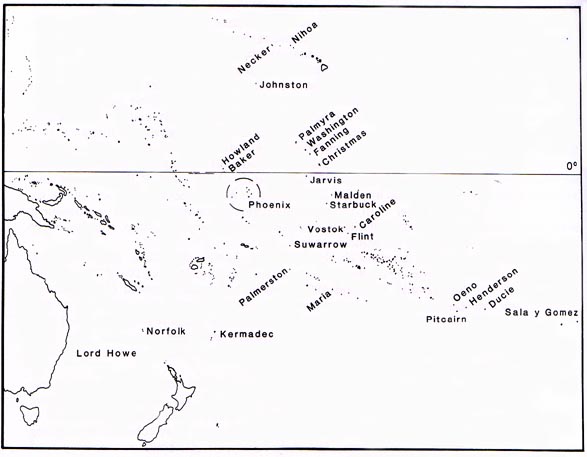
Most of the "mystery islands" were quite habitable, and could have sustained some level of prehistoric population; but when discovered by Europeans, they were unpopulated. In almost all cases, we do not know why this was so. Perhaps it was climate change, environmental overload, collapse of the food supply, internal conflict, or simple wanderlust - something drove these people to extinction, or to take their chances once again on the vast Pacific. This is an enduring and fascinating puzzle for which there are no ready answers.
This bibliography gathers together the available research on three of these "mystery" island groups - Norfolk Island, the Kermadec Islands, and the Auckland Islands. These islands are amongst the most remote on earth, but both were definitely settled at some point by prehistoric Polynesian seafarers. However, when "rediscovered" by Europeans in the late 18th century, they were utterly abandoned. How and why did this happen? Who were these people? Where did they go? The references below are primarily the work of archaeologists, who have teased out the fragmentary and tantalizing evidence for these vanished visitors.
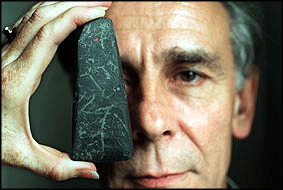
Dr. Jim Specht with a Norfolk Island blade
Norfolk Island
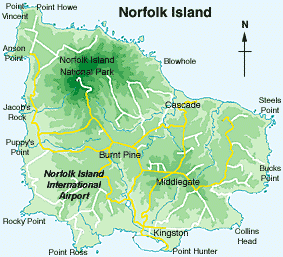
 About Norfolk Island
About Norfolk Island The Guide to Norfolk Island
The Guide to Norfolk Island Pitcairners Norfolk Website
Pitcairners Norfolk WebsiteBibliography
 Anderson, Atholl J.
Anderson, Atholl J.
- "Taking to the Boats: The Prehistory of Indo-Pacific Colonization." Public Lecture for the National Institute of Asia and the Pacific. 18 Dec. 2002.
 Anderson, Atholl J., and Peter White.
Anderson, Atholl J., and Peter White.
- "Approaching the Prehistory of Norfolk Island." The Prehistoric Archaeology of Norfolk Island, Southwest Pacific. Canberra: Australian National Museum, 2001. 1-10.
 Anderson, Atholl J., et al.
Anderson, Atholl J., et al.
- "Archaeological Fieldwork on Norfolk Island." The Prehistoric Archaeology of Norfolk Island, Southwest Pacific. Canberra: Australian National Museum, 2001. 11-32.

 Anderson, Atholl J.
Anderson, Atholl J.
- "Differential Reliability of 14C AMS Ages of Rattus Exulans Bone Gelatin in South Pacific Prehistory." Journal of The Royal Society of New Zealand 30.3 (2000): 243-261.
 Anderson, Atholl J.
Anderson, Atholl J.
- "Discovery of a Prehistoric Habitation Site on Norfolk Island." Journal of the Polynesian Society 105 (1996): 479-486.
 Anderson, Atholl J., and Roger Green.
Anderson, Atholl J., and Roger Green.
- "Domestic and Religious Structures in the Emily Bay Settlement Site, Norfolk Island." The Prehistoric Archaeology of Norfolk Island, Southwest Pacific. Canberra: Australian National Museum, 2001. 43-52.
 Anderson, Atholl J.
Anderson, Atholl J.
- "Faunal Collapse, Landscape Change and Settlement History in Remote Oceania." World Archaeology 33.3 (2002): 375-390.
 Anderson, Atholl J., and Richard N. Holdaway.
Anderson, Atholl J., and Richard N. Holdaway.
- "14C Dates on Rattus Exulans Bones from Natural and Archaeological Contexts on Norfolk Island, South-West Pacific." Archaeology in New Zealand 41.3 (1998): 195-198.
 Anderson, Atholl J., and M. Spriggs.
Anderson, Atholl J., and M. Spriggs.
- "Late Colonisation of East Polynesia." Antiquity 67 (1993): 200-217.
 Anderson, Atholl J., et al.
Anderson, Atholl J., et al.
- "Material Sources of Basalt and Obsidian Artifacts from a Prehistoric Settlement Site on Norfolk Island, South Pacific." Archaeology in Oceania 32.1 (1997): 39-46.
 Anderson, Atholl J.
Anderson, Atholl J.
- "No Meat on That Beautiful Shore: The Prehistoric Abandonment of Subtropical Polynesian Islands." International Journal of Osteoarchaeology 11 (2000): 14-23.
"In the Pacific there are two main groups of so-called mystery islands, i.e. islands that were settled and then abandoned (or their populations died out) in prehistory. One consists of low coral islands in the equatorial zone and the other of high basaltic islands in the subtropical zone. Consideration of environmental and archaeological evidence about the latter suggests that they lay in a relatively impoverished zone of faunal resources (marine mammals, seabirds, inshore fish and invertebrates) and were also marginal to the full deployment of tropical agriculture. It is argued that vulnerability to significant faunal depletion by over-exploitation, without the ability to compensate by agricultural production provides an explanation of settlement discontinuation in the subtropical islands and potentially for the mystery islands as a whole."
 Anderson, Atholl J., and Peter White.
Anderson, Atholl J., and Peter White.
- "Prehistoric Settlement on Norfolk Island and its Oceanic Context." The Prehistoric Archaeology of Norfolk Island, Southwest Pacific. Canberra: Australian National Museum, 2001. 135-141.
 Anderson, Atholl J., et al.
Anderson, Atholl J., et al.
- "The Radiocarbon Chronology of the Norfolk Island Archaeological Sites." The Prehistoric Archaeology of Norfolk Island, Southwest Pacific. Canberra: Australian National Museum, 2001. 33-42.
 Anderson, Atholl J.
Anderson, Atholl J.
- "Retrievable Time: Prehistoric Colonisation of South Polynesia From the Outside In and the Inside Out." Disputed Histories: Imagining New Zealand's Pasts. Ed. Tony Ballantyne and Brian Moloughney. Dunedin: Otago University Press, 2006. 25-41.
 Bulbeck, F. D., and C. P. Groves.
Bulbeck, F. D., and C. P. Groves.
- "Skeletal Remains from Grave 608, Norfolk Island." The Prehistoric Archaeology of Norfolk Island. Honolulu: Bishop Museum, 1984. 57-74.
 Campbell, Colin R., and Lyn Schmidt.
Campbell, Colin R., and Lyn Schmidt.
- "Molluscs and Echinoderms from the Emily Bay Settlement Site, Norfolk Island." The Prehistoric Archaeology of Norfolk Island, Southwest Pacific. Canberra: Australian National Museum, 2001. 109-114.
 Dayton, Leigh.
Dayton, Leigh.
- "Now We Know Who Beat Cook to Norfolk." Sydney Morning Herald 2 April 1997: 4.
"When Captain Cook dropped anchor at Norfolk Island in 1774, nobody was home. Yet when the island's penal colony was established in 1788, puzzled residents discovered stone tools on the beaches and cultivated bananas in the forest. Somebody had been there. But who? Sketchy archaeological evidence has long pointed to either Melanesian people from nearby New Caledonia, or to Polynesians from eastern Pacific islands. But which? At last, archaeologists have the answer. The first settlers arrived between 400 and 800 years ago from New Zealand, with a stop-over at the Kermadec Islands..."
 Diamond, J. M.
Diamond, J. M.
- "Why Did the Polynesians Abandon Their Mystery Islands?" Nature 317 (1985): 764.
 Green, T. H.
Green, T. H.
- "Petrologic Evaluation of Artifact Material from Norfolk Island." The Prehistoric Archaeology of Norfolk Island. Honolulu: Bishop Museum, 1984. 53-56.
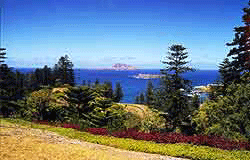
 Groves, C. P.
Groves, C. P.
- "The Human Femoral Specimen from the Sand Pit at Cemetery Bay." The Prehistoric Archaeology of Norfolk Island. Honolulu: Bishop Museum, 1984. 75-76.
 Hoare, Merval.
Hoare, Merval.
- "The Discovery of Norfolk Island." Australian External Territories 10.2 (1970): 8-11.
 Hoare, Merval.
Hoare, Merval.
- Norfolk Island: A Revised and Enlarged History, 1774-1998. Rockhampton, Qld: Central Queensland University Press, 1999. 228p.
 Holdaway, Richard N., and Atholl J. Anderson.
Holdaway, Richard N., and Atholl J. Anderson.
- "Avifauna from the Emily Bay Settlement Site, Norfolk Island: A Preliminary Account." The Prehistoric Archaeology of Norfolk Island, Southwest Pacific. Canberra: Australian National Museum, 2001. 85-100.
 MacPhail, Mike K., et al.
MacPhail, Mike K., et al.
- "Polynesian Plant Introductions in the Southwest Pacific: Initial Pollen Evidence from Norfolk Island." The Prehistoric Archaeology of Norfolk Island, Southwest Pacific. Canberra: Australian National Museum, 2001. 123-134.
 Matisoo-Smith, Elizabeth, et al.
Matisoo-Smith, Elizabeth, et al.
- "Genetic Variation in Archaeological Rattus Exulans Remains from the Emily Bay Settlement Site, Norfolk Island." The Prehistoric Archaeology of Norfolk Island, Southwest Pacific. Canberra: Australian National Museum, 2001. 81-84.
 McCarthy, F. D.
McCarthy, F. D.
- "Norfolk Island: Additional Evidence of a Former Native Occupation." Journal of the Polynesian Society 43 (1934): 267-270.
 Menham, G.
Menham, G.
- "Reappraising Norfolk Island History." Australian External Territories 10:4 (1970): 15-18.

Emily Bay - site of earliest Polynesian settlement
 Neuweger, Diana, et al.
Neuweger, Diana, et al.
- "Land Snails from Norfolk Island Sites." The Prehistoric Archaeology of Norfolk Island, Southwest Pacific. Canberra: Australian National Museum, 2001. 115-122.
 Nobbs, Raymond.
Nobbs, Raymond.
- Norfolk Island and Its First Settlement, 1788-1814. North Sydney, NSW: Library of Australian History, 1988. 244p.
 Ritchie, Neville.
Ritchie, Neville.
- "Archaeology and History of Norfolk Island." Archaeology in New Zealand 32 (1989): 118-134.
 Sampson, Helen.
Sampson, Helen.
- Over the Horizon: The Polynesian Settlement on Norfolk Island. Kingston: Norfolk Island Museum, 2005. 14p.
 Schmidt, Lyn, et al.
Schmidt, Lyn, et al.
- "Shell and Bone Artefacts from the Emily Bay Settlement Site, Norfolk Island." The Prehistoric Archaeology of Norfolk Island, Southwest Pacific. Canberra: Australian National Museum, 2001. 67-74.

 Smith, Ian, et al.
Smith, Ian, et al.
- "Mammalian and Reptilian Fauna from Emily and Cemetery Bays, Norfolk Island." The Prehistoric Archaeology of Norfolk Island, Southwest Pacific. Canberra: Australian National Museum, 2001. 75-80.
 Specht, Jim, et al.
Specht, Jim, et al.
- "Additional Evidence for Pre-1788 Visits by Pacific Islanders to Norfolk Island, South-West Pacific." Records of the Australian Museum Supplement 17 (1993): 145-157.
 Specht, Jim, and L. Hosking.
Specht, Jim, and L. Hosking.
- "The Early Mystery of Norfolk Island." Australian Natural History 19.7 (1978): 218-223.
 Specht, Jim, et al.
Specht, Jim, et al.
- "A Minimum Date for Polynesian Visitation to Norfolk Island, South-West Pacific, from Faunal Evidence." Search 16: 304-306.
 Specht, Jim, ed.
Specht, Jim, ed.
- The Prehistoric Archaeology of Norfolk Island. Honolulu: Bishop Museum, 1984. 76p.
Series: Pacific Anthropological Records no. 34.
 Thorpe, W. W.
Thorpe, W. W.
- "Evidence of Polynesian Culture in Australia and Norfolk Island." Journal of the Polynesian Society 38 (1929): 123-126.
 Turner, Marianne, et al.
Turner, Marianne, et al.
- "Stone Artefacts from the Emily Bay Settlement Site, Norfolk Island." The Prehistoric Archaeology of Norfolk Island, Southwest Pacific. Canberra: Australian National Museum, 2001. 53-66.
 Varman, Rob.
Varman, Rob.
- "Conchological Study of Norfolk Island Terrestrial Mollusca from Fossiliferous and Live Populations."
 Varman, Rob.
Varman, Rob.
 Walter, Richard, and Atholl J. Anderson.
Walter, Richard, and Atholl J. Anderson.
- "Fishbone from the Emily Bay Settlement Site, Norfolk Island." The Prehistoric Archaeology of Norfolk Island, Southwest Pacific. Canberra: Australian National Museum, 2001. 101-108.
 Weisler, Marshall I.
Weisler, Marshall I.
- Prehistoric Long-Distance Interaction in Oceania: An Interdisciplinary Approach. Auckland: New Zealand Archaeological Association, 1997. 237p.
Series: New Zealand Archaeological Association Monograph no. 21.
 Woodford, James.
Woodford, James.
- "Revealed: Ancient Residents of Norfolk." Sydney Morning Herald 9 Feb. 1999: 8.
"More than 170 years before Captain James Cook arrived in the South Pacific a small community of Polynesians vanished from their Norfolk Island home - killed by disease, struck by disaster or murdered when they escaped to Australia. They had lived on the island for as long as 400 years, from 1200 to 1600, and while their fate will never be known, a team of archaeologists has for the first time uncovered evidence of their village and a minute glimpse into their daily life."
The Kermadec Islands
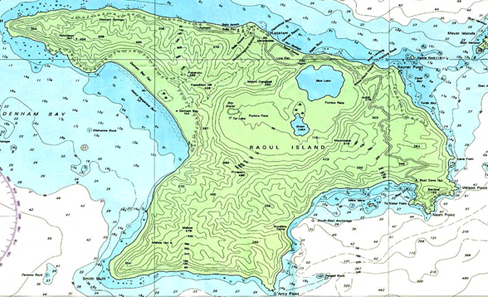
Map of Raoul Island
The Kermadec Archipelago lies about 600 mi. northeast of Auckland, halfway between New Zealand and Tonga. The land area is about the same as Norfolk, at 13 sq. miles, but the islands are less habitable. The largest island, Raoul, covers 11.2 sq. miles, and rises to 1700 feet at Mt. Moumoukai. There are smaller islands and islets in the archipelago, including Curtis, Macaulay, and L'Esperance. The islands are prone to volcanic activity and earthquakes, which may have been a factor in their early settlement history.
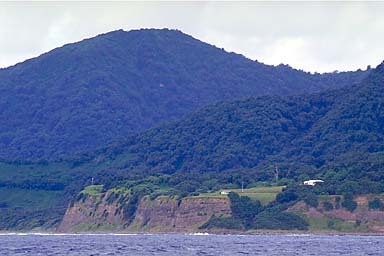
Only Raoul is habitable - heavily wooded and fertile, with 57" of rain a year. Nikau palm, pohutukawa, and karaka forests flourish. There are small lakes and lagoons, and extensive tropical/temperate coastal marine ecosystems with corals but no coral reefs. In prehistoric times the environment could have supported a resident population, although the ecological integrity of the islands has deteriorated since European discovery. They are now heavily protected by the New Zealand government, and the environment is being gradually restored. Currently, the only inhabitants are scientists and weather station personnel.
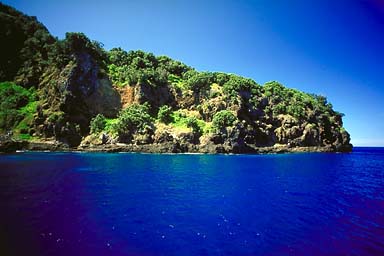
 New Zealand Archaeological Association website.
New Zealand Archaeological Association website.Bibliography
 Anderson, Atholl J.
Anderson, Atholl J.
- "The Archaeology of Raoul Island (Kermadecs) and its Place in the Settlement History of Polynesia." Archaeology and Physical Anthropology in Oceania 15 (1980): 131-141.
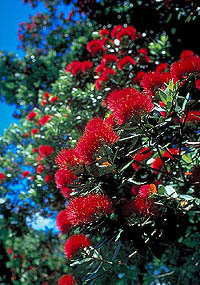
 Anderson, Atholl J.
Anderson, Atholl J.
- "The Chronology of Colonization in New Zealand." Antiquity 65 (1991): 767-795.
 Anderson, Atholl J.
Anderson, Atholl J.
- "The 1978 Raoul Island Archaeological Expedition: An Interim Report." New Zealand Archaeological Association Newsletter 22 (1979): 76-82.

 Anderson, Atholl J., and Bruce McFadgen.
Anderson, Atholl J., and Bruce McFadgen.
- "Prehistoric Two-way Voyaging Between New Zealand and East Polynesia: Mayor Island Obsidian on Raoul Island and Possible Raoul Island Obsidian in New Zealand." Archaeology In Oceania 25 (1990): 37-42.
 Coppell, William G.
Coppell, William G.
- Bibliographies of the Kermadec Islands, Niue, Swains Island and the Tokelau Islands. Honolulu: Pacific Islands Studies Program, University of Hawaii, 1975. 99p.
 Duff, Roger.
Duff, Roger.
- "Stone Adzes from Raoul, Kermadec Islands." Journal of the Polynesian Society 77 (1968): 386-401.
 Edgar, A. T., et al.
Edgar, A. T., et al.
- "Kermadecs Expedition, 17-25 November." Notornis 12 (1965): 3-43.
 Irwin, Geoffrey.
Irwin, Geoffrey.
- "Against, Across and Down the Wind: A Case for the Systematic Exploration of the Remote Pacific Islands." Journal of the Polynesian Society 98 (1989): 167-206.
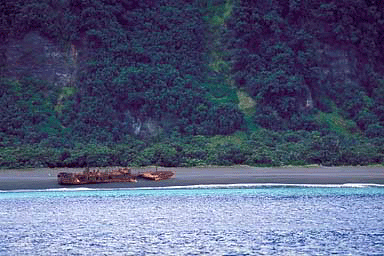
 Irwin, Geoffrey.
Irwin, Geoffrey.
- "The Kermadec, Norfolk, Chatham and Line Islands." The Prehistoric Exploration and Colonisation of the Pacific
 Johnson, Leigh.
Johnson, Leigh.
- A History and Archaeological Survey of Raoul Island, Kermadec Islands. Auckland: Dept. of Conversation, Auckland Conservancy, 1991.
Series: Auckland Conservancy Technical Reports no. 2.
 Johnson, Leigh.
Johnson, Leigh.
- In the Midst of a Prodigious Ocean: Archaeological Investigations of Polynesian Settlement of the Kermadec Islands. Auckland: Dept. of Conversation, Auckland Conservancy, 1995. 130p.
Series: Auckland Conservancy Historic Resources no. 11.
 Johnson, Leigh, and Thomas Higham.
Johnson, Leigh, and Thomas Higham.
- "The Prehistoric Chronology of Raoul Island, the Kermadec Group." Archaeology in Oceania 32 (1996): 207-213.
 "The Kermadec Islands: Archaeological and Historical Values." Heritage Expeditions.
"The Kermadec Islands: Archaeological and Historical Values." Heritage Expeditions. Kirch, Pat.
Kirch, Pat.
- "On the Genetic and Cultural Relationships of Certain Polynesian Outlier Populations." American Journal of Physical Anthropology 66.4 (1985): 381-382.
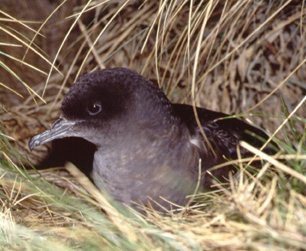
 Kirch, Pat.
Kirch, Pat.
- "The Polynesian Outliers: Continuity, Change, and Replacement." Out of Asia: Peopling the Americas and the Pacific. Ed. R. Kirk and E. Szathmary. Canberra: Journal of Pacific History, 1984. 206-221.
 Kirch, Pat.
Kirch, Pat.
- "Polynesia's Mystery Islands." Archaeology May-June 1988: 26-31.
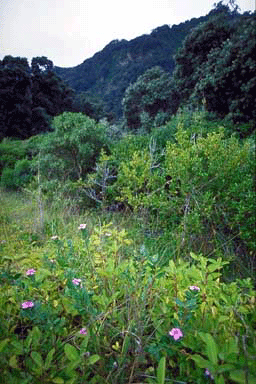
 Kirch, Pat, and J. Ellison.
Kirch, Pat, and J. Ellison.
- "Palaeoenvironmental Evidence for Human Colonisation of Remote Oceanic Islands." Antiquity 68 (1994): 310-321.
 Leach, Foss, et al.
Leach, Foss, et al.
- "The Origin of Prehistoric Obsidian Artefacts from the Chatham and Kermadec Islands." New Zealand Journal of Archaeology 8 (1986): 143-170.
 Matisoo-Smith, Elizabeth, et al.
Matisoo-Smith, Elizabeth, et al.
- "Ancient DNA from Polynesian Rats: Extraction, Amplification and Sequence from Single Small Bones." Electrophoresis 18.9 (1997): 1534-1537.
 Matisoo-Smith, Elizabeth, et al.
Matisoo-Smith, Elizabeth, et al.
- "Patterns of Prehistoric Human Mobility in Polynesia Indicated by mtDNA from the Pacific Rat." Proceedings of the National Academy of Sciences 95 (1998): 15145-15150.
 Matisoo-Smith, Elizabeth, et al.
Matisoo-Smith, Elizabeth, et al.
- "Prehistoric Mobility in Polynesia: mtDNA Variation in Rattus Exulans from the Chatham and Kermadec Islands." Asian Perspectives 38.2 (1999): 186.
 Oliver, Reginald B.
Oliver, Reginald B.
- Vegetation of the Kermadec Islands. Wellington: Govt. Printing Office, 1910. 175p.
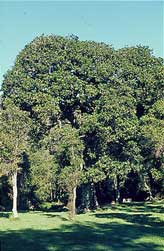
 Roberts, M.
Roberts, M.
- "Origin, Dispersal Routes and Geographic Distribution of Rattus Exulans, with Special Reference to New Zealand."
Pacific Science 45 (1991): 123-130.
 Sutton, Douglas G., ed.
Sutton, Douglas G., ed.
- The Origins of the First New Zealanders. Auckland: Auckland University Press, 1994. 269p.
 Sutton, Douglas G.
Sutton, Douglas G.
- "A Paradigmatic Shift in Polynesian Prehistory: Implications for New Zealand." New Zealand Journal of Archaeology 9 (1987): 135-155.
 Wright, A. E., ed.
Wright, A. E., ed.
- The Offshore Islands of Northern New Zealand: Proceedings of a Symposium Convened by the Offshore Islands Research Group in Auckland, 10-13 May, 1983. Wellington: Department of Lands and Survey, 1986.
Lord Howe Island
-
Lord Howe Island lies in the Tasman Sea, 440 miles northeast of Sydney, Australia. The island is about 7 sq. miles, and has an excellent climate and a reef system. It was discovered in 1788 by a British ship. It appears that before that moment, no human had laid eyes on Lord Howe, so it remains one of the unique places on the planet that never had an indigenous population. Some archaeological work has been carried out to test the hypothesis that Lord Howe was truly undiscovered, and so far there has been no evidence of a prehistoric population. Even for the intrepid Polynesians, Lord Howe would have been an incredible voyaging achievement, and it appears unlikely that Australian aboriginals ever had the sailing technology to venture that far from the coast. However, an interesting hypothesis is that Lord Howe was struck by a mega-tsunami caused by collision with an extraterrestrial object. This cataclysm (in 1500AD) could have obliterated any settlement on the island.
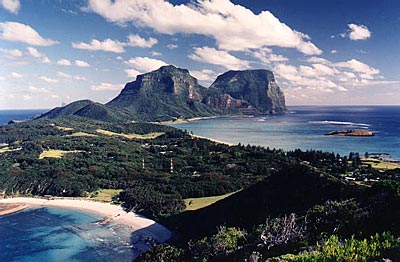
 About Lord Howe Island
About Lord Howe Island Lord Howe Island - Wikipedia
Lord Howe Island - Wikipedia More on Lord Howe Island
More on Lord Howe Island "Islands We'd Love to be Stranded On." Outside Magazine 1999 Annual Travel Guide.
"Islands We'd Love to be Stranded On." Outside Magazine 1999 Annual Travel Guide.Bibliography
 Abbott, Dallas H., et al.
Abbott, Dallas H., et al.- "Did a Bolide Impact Cause Catastrophic Tsunamis in Australia and New Zealand?" Geological Society of America 2003 Annual Meeting 2-5 Nov. 2003, Seattle, Washington.
 Anderson, Atholl J.
Anderson, Atholl J.- "Investigating Early Settlement on Lord Howe Island." Australian Archaeology 57 (2003): 98-102.
"A survey of unconsolidated sediments overlying Pleistocene calcarenites and Tertiary basalts on Lord Howe Island was undertaken in 1996 in order to test the hypothesis that human settlement had not occurred before the European era, beginning in AD 1788. The results, largely from augering in lowland areas suitable for settlement, showed almost no sign of human occupation, and two radiocarbon dates on charcoal from sand-dune deposits are both modern."
 Bryant, Edward.
Bryant, Edward.- "Periodic Mega-Tsunami in the Southwest Pacific: Physical and Human Impacts." Conference on Environmental Catastrophes and Recoveries in the Holocene 29 Aug. - 2 Sept. 2002, Brunel University, Uxbridge, UK.
 Macphail, M.
Macphail, M.- Report: Latest Holocene Palynological Sites, Lord Howe Island. 1996. Unpublished research notes.
 McDougall, I., B.J.J. Embleton, and D.B. Stone.
McDougall, I., B.J.J. Embleton, and D.B. Stone.- "Origin and Evolution of Lord Howe Island, Southwest Pacific Ocean" Journal of the Geological Society of Australia (1981): 155-176.
 Patterson, Colin
Patterson, Colin- "Environment: Tsunamis may have hit Maori of old."
"Thousands of people died and coastal communities were devastated after tsunamis struck New Zealand's east coast from Otago to Northland 500 to 600 years ago, an anthropologist says. Bruce McFadgen, of Wellington, is writing a book on coastal calamities - including tsunamis - that struck Maori communities in the 15th century. At the time most Maori lived close to the sea. "About half of settlements were within a kilometre of the coast. That provided the best access to food and good soils for gardening. With almost all the land covered by forest, the sea was the main means of transport." Dr. McFadgen says "a series of catastrophes" caused large-scale loss of life and major changes to the coastal environment."
The Auckland Islands, The Snares, Campbell, Bounty and the Antipodes Islands
-
The Auckland Islands are considerably different than Norfolk and the Kermadecs. They are a sub-Antarctic archipelago, with a harsh, cold, windy climate, situated about 300 miles south of the South Island of New Zealand. Incredibly, evidence is emerging that prehistoric Polynesians voyaged to these islands on the edge of the Antarctic; a truly astounding feat of seamanship and endurance. Archaeologists are still uncovering the tenuous evidence for these most far-flung of the Polynesian discoverers, and as yet we know little about their settlement, which took place in the 13th and 14th centuries. There is one archaeological site at Sandy Bay on Enderby Island, a small island to the north of the main Auckland Island. Enderby has the best habitat of the archipelago, and is relatively sheltered from the prevailing winds. There is also easy access to nearby seal colonies.
Various archaeological relics had been collected from Sandy Bay over the years, but excavations in the late 1990s by Atholl Anderson finally proved that the site had been occupied 600-700 years ago.
In the 19th century, during historic times, Polynesians once again settled in the Aucklands for about 20 years, this time arriving by European sailing ship. These were Taranaki Maoris from the Chatham Islands, accompanied by their Moriori slaves. This settlement was not successful, and the survivors were evacuated back to the South Island in the 1850s.
Rakiura is the Maori name for Stewart Island, which probably served as a launching point for voyaging to the Auckland archipelago. Maori settlement on Rakiura was extensive. The Snares are a small forested group of islets 64 miles south of Rakiura which show evidence of occasional visits. An archaic adze has been discovered there. One of the larger islands was known to the Maoris as Te Taniwha ("The Dragon").
Campbell Island and Bounty Island are even more remote sub-Antarctic Islands well south of New Zealand that have yet to reveal evidence of Polynesian settlement. There is tantalizing evidence of a Polynesian visit to the Antipodes Islands - a fragment of Polynesian pottery now in the Te Papa Museum in Wellington.
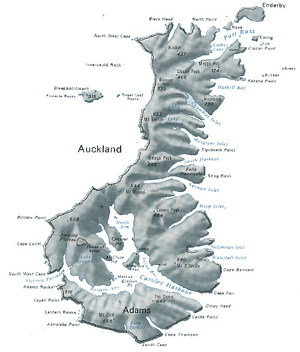
Map of the Auckland Archipelago
Large scale map
Bibliography
 Anderson, Atholl J.
Anderson, Atholl J.
- "Subpolar Settlement in South Polynesia." Antiquity 79.306 (2005): 791-800.
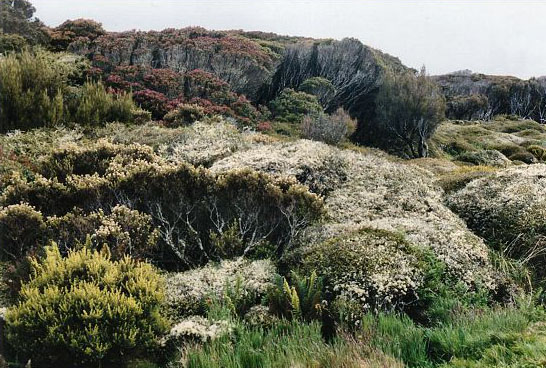
Landscape of the Auckland Islands
 Anderson, Atholl J., and Gerard R. O'Regan.
Anderson, Atholl J., and Gerard R. O'Regan.
- "The Maori Archaeology of Southern Rakiura." Southern Margins Project Report. Dunedin: Ngai Tahu Development Report, 1999.
 Anderson, Atholl J., and Gerard R. O'Regan.
Anderson, Atholl J., and Gerard R. O'Regan.
- "The Polynesian Archaeology of the Subantarctic Islands: An Initial Report on Enderby Island." Southern Margins Project Report. Dunedin: Ngai Tahu Development Report, 1999.
 Anderson, Atholl J.
Anderson, Atholl J.
- Prehistoric Archaeology in the Auckland Islands: New Zealand Subantarctic Region. Wellington: Dept. of Conservation, 2003. 28p.
 Anderson, Atholl J., and Gerard R. O'Regan.
Anderson, Atholl J., and Gerard R. O'Regan.
- "To the Final Shore: Prehistoric Colonisation of the Subantarctic Islands in South Polynesia." Australian Archaeologist: Collected Papers in Honour of Jim Allen. Canberra: Australian National University, 2000. 440-454.
 Auckland Islands - Wikipedia
Auckland Islands - Wikipedia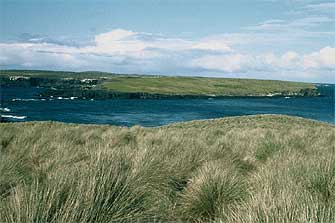
Enderby Island
 Coutts, P. J. F.
Coutts, P. J. F. - "The Emergence of the Foveaux Strait Maori from Prehistory: A Study of Culture Contact." Diss. University of Otago, 1972.
 Dingwall, P. R.
Dingwall, P. R.
- "Castaways of the Auckland Islands: The Changing Image of the Auckland Islands." Landscape 8 (1980), 9 (1981).
 Hulford, Paul.
.
Hulford, Paul.
. Matisoo-Smith, Elizabeth, et al.
Matisoo-Smith, Elizabeth, et al.
- "The Origins of the Feral Pigs on the Auckland Islands." Journal of the Royal Society of New Zealand 33 (2003): 561-569.
 McNab, R.
McNab, R.
- Murihiku and the Southern Islands: A History of the West Coast Sounds, Foveaux Strait, Stewart Island, The Snares, Bounty, Antipodes, Auckland, Campbell and Macquarie Islands from 1770 to 1829. Auckland: Wilson and Horton, 1970.
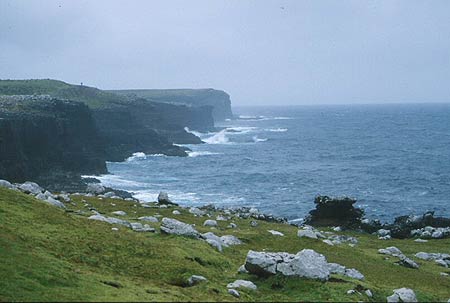
Enderby Island
 O'Connor, Tom.
O'Connor, Tom.
- "Polynesians in the Southern Ocean: Occupation of the Auckland Islands in Prehistory." New Zealand Geographic 69 (Sept.-Oct. 2004): 6-8.
 Pierce, G. L.
Pierce, G. L.
- "Nga-iwi-o-aotea." Te Ao Hou 59 (June 1967): 43.
 Royal Society of NZ: Auckland Islands Bicentennial
Royal Society of NZ: Auckland Islands Bicentennial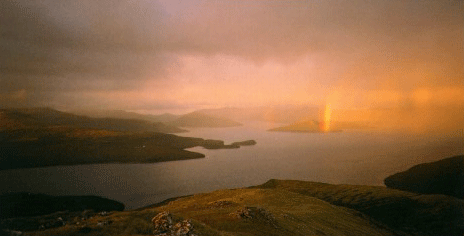
The Auckland Islands - beautiful and desolate
 Scadden, K.
Scadden, K.
- "The Auckland Islands, 1806-1900: Research in Progress." Archifacts 1 (1988): 2-15.
 Sessions, Laura.
Sessions, Laura.
- "Date with Extinction: For a Thousand Years before People Settled in
New Zealand, a Small Alien Predator May Have Been Undermining the Islands' Seabird Populations." Natural History Magazine April 2003.
 "Snares Site 1 and Auckland Islands Site 53: NZAA Site Record Forms." Ms.
"Snares Site 1 and Auckland Islands Site 53: NZAA Site Record Forms." Ms. Sutton, Douglas G.
Sutton, Douglas G.
- "Coastal Hunting in the Subantarctic Zone." New Zealand Journal of Archaeology 2 (1980): 135-155.
 Sutton, Douglas G. et al.
Sutton, Douglas G. et al.
- "Towards the Recognition of Convergent Cultural Adaptation in the Subantarctic Zone." Current Anthropology 23.1 (Feb. 1982): 77-97.
 Wallace, R.
Wallace, R.
- "Auckland Islands: Charcoal Identifications and Dating Sample Selection." Southern Margins Project Report. Dunedin: Ngai Tahu Development Report, 1999.
West, Carol.
- New Zealand Subantarctic Islands Research Strategy. NZ Dept. of Conservation, Southland Conservancy, 2005. 38p.
| Lane Community College Library, Center
Building, 4000 East 30th Ave, Eugene, OR 97405 Questions or comments regarding this website can be directed to Don Macnaughtan. Email: macnaughtand@lanecc.edu. This page was last updated: 30 December, 2004 ©2004 Lane Community College |

